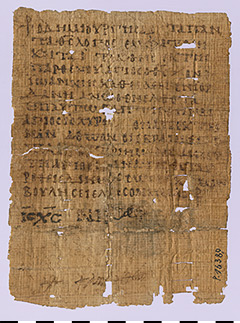P. 16389
“Holy is God“, “holy and strong” and ”holy and immortal” is not just a Three-Times-Holy-Call to the Holy Trinity. It also gives the hymn its name. Trishagion-hymn. It is one of the oldest hymns of the Christian church. And until now, 1300 years later, it is sung by the Copts. Still in Greek.
The papyrus is written with careful and faultless capital letters of the Greek language. The author only used the front. The back of the piece is empty. Unfortunately, it is unknown, who wrote these 13 lines in the 7th century. Just like the origin. But thanks to Carl Schmidt, who bought them in 1937, we now can see them in the “Neues Museum” in Berlin. The Papyrus is very well conserved except for a few little holes and a lightly broken edge.
The hymn, which has three strophes, was written with dark brown ink. It is 16,5 cm high and 12,5 cm wide. Above and at the sides is a border of 1 cm. Despite the continuous writing, the end of the first and second strophe is tagged by a slash and a double gap. Every strophe, except for the third (there it is in the middle), is followed by the trishagion, like an ending and/or refrain. In front of the text is a christogram, which is repeated at the end, just in a smaller version. Under the last line the words “Jesus Christ triumphs” (of course also in Greek) are written in a thicker handwriting but from the same person. At the very bottom a note is written with light brown ink. But probably this was add later and by a different person and it has no connection with the hymn.
In three strophes the hymn talks about the history of Jesus, which is summarized to birth, baptism and death and resurrection. The first strophe tells us something about the decision of God to “create” Jesus and about Maria. It ends with the words “holy is God“. The second strophe reports the process of baptism Jesus, where and by whom he was baptised. It closes with the words “holy and strong“. And the last strophe narrates death and resurrection. It refers to Pilatus, who ordered to kill Jesus and how Jesus rose from death after three days. After that stands “holy and immortal“. But unlike the other two strophes it does not end there. There are a few more words to praise and thank Jesus and ask for mercy.
With this kind of papyri it is not easy to say, whether it is private or used during church-services. But because of a parallel one can put it into a church context. The hymn was sung on the 4th Sunday after Epiphany. As said before, the version of the hymn one sees is not actually the only one. There is one more as part of a manuscript, which is in the exhibition of the “Rijkmuseum van Oudheden” in Leiden. This manuscript was found by the historian Jan Herman Insinger at the “White Monastery” in the 1890s. But the Berlin version is in a better shape.
The piece does not provide great insides into the life of the people back then but one can conclude the value of God and Jesus for them. Furthermore, that the text survived one and a half thousand years says much about the importance of the religion.



